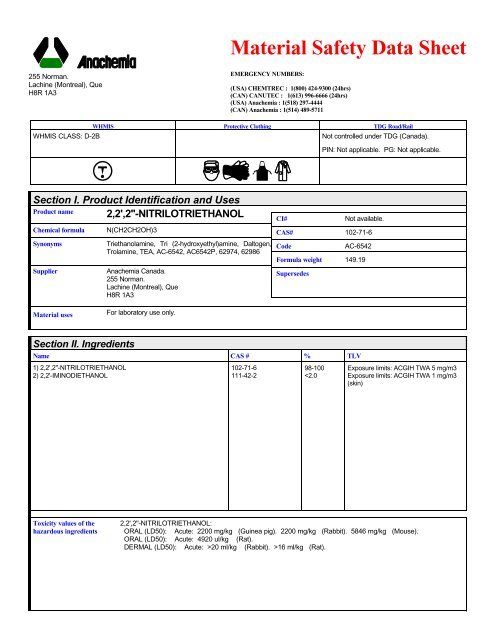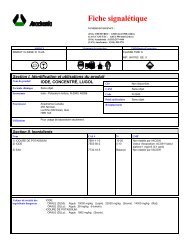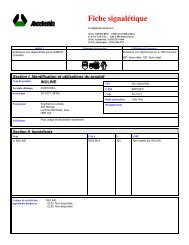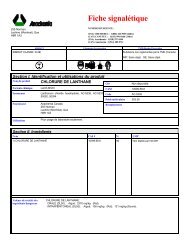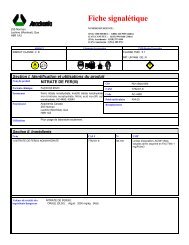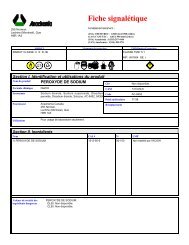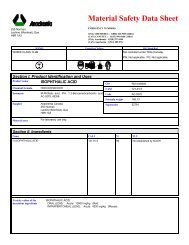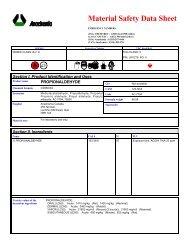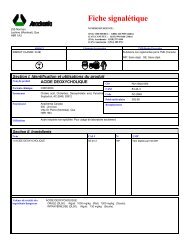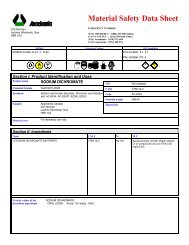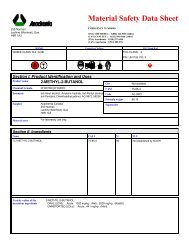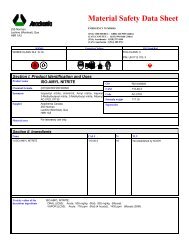5457 2,2',2''-NITRILOTRIETHANOL (English) ANACHEMIA MSDS ...
5457 2,2',2''-NITRILOTRIETHANOL (English) ANACHEMIA MSDS ...
5457 2,2',2''-NITRILOTRIETHANOL (English) ANACHEMIA MSDS ...
Create successful ePaper yourself
Turn your PDF publications into a flip-book with our unique Google optimized e-Paper software.
255 Norman.<br />
Lachine (Montreal), Que<br />
H8R 1A3<br />
Section I. Product Identification and Uses<br />
Product name 2,<strong>2'</strong>,<strong>2'</strong>'-<strong>NITRILOTRIETHANOL</strong><br />
Chemical formula<br />
Synonyms<br />
Material uses<br />
N(CH2CH2OH)3<br />
Section II. Ingredients<br />
Triethanolamine, Tri (2-hydroxyethyl)amine, Daltogen,<br />
Trolamine, TEA, AC-6542, AC6542P, 62974, 62986<br />
Anachemia Canada.<br />
255 Norman.<br />
Lachine (Montreal), Que<br />
H8R 1A3<br />
For laboratory use only.<br />
Material Safety Data Sheet<br />
WHMIS Protective Clothing TDG Road/Rail<br />
WHMIS CLASS: D-2B Not controlled under TDG (Canada).<br />
Supplier<br />
CI#<br />
CAS# 102-71-6<br />
Code AC-6542<br />
Formula weight<br />
Supersedes<br />
PIN: Not applicable. PG: Not applicable.<br />
Not available.<br />
1) 2,<strong>2'</strong>,<strong>2'</strong>'-<strong>NITRILOTRIETHANOL</strong> 102-71-6 98-100 Exposure limits: ACGIH TWA 5 mg/m3<br />
2) 2,<strong>2'</strong>-IMINODIETHANOL 111-42-2
Section III. Physical Data<br />
Physical state and<br />
appearance / Odor<br />
pH (1% soln/water)<br />
Odor threshold<br />
Percent volatile<br />
Freezing point<br />
Boiling point<br />
Specific gravity<br />
Vapor density<br />
Vapor pressure<br />
Water/oil dist. coeff.<br />
Evaporation rate<br />
Solubility<br />
Water-white liquid; Mild ammoniacal odor.<br />
Not available.<br />
Not available.<br />
0.06%<br />
17.9 to 22°C (supercools)<br />
335°C<br />
1.126 (Water = 1)<br />
5.14 (Air = 1)<br />
0.01 mm of Hg @ 20°C<br />
Not available.<br />
Section V. Toxicological Properties<br />
Effects of Chronic<br />
Overexposure<br />
Section VI. First Aid Measures<br />
Eye contact<br />
Skin contact<br />
Inhalation<br />
Ingestion<br />
Stability<br />
Hazardous decomp.<br />
products<br />
Incompatibility<br />
If conscious, wash out mouth with water. Have conscious person drink several glasses of water to dilute. Induce<br />
vomiting. Call a physician. Never give anything by mouth to an unconscious or convulsing person.<br />
Section VII. Reactivity Data<br />
Reaction Products<br />
Unstable. Air and light sensitive. Conditions to avoid: High temperatures, sparks, open flames and all other sources of<br />
ignition, contamination.<br />
Temperatures above 250°C - may undergo self-sustaining thermal decomposition.<br />
2,<strong>2'</strong>,<strong>2'</strong>'-<strong>NITRILOTRIETHANOL</strong> page 3/4<br />
Repeated exposure may cause kidney and liver damage. Skin contact may cause sensitization and an allergic skin reaction<br />
in a small proportion of individuals. Because of its irritating properties, this material may aggravate an existing dermatitis.<br />
Carcinogenic effects: Not available. Mutagenic effects: Not available. Teratogenic effects: Not available. Toxicity of the<br />
product to the reproductive system: Not available. To the best of our knowledge the chronic toxicity of this substance has not<br />
been fully investigated. Medical conditions which may be aggravated: Individuals with preexisting diseases of the skin, eye,<br />
or respiratory system may be more susceptible to the toxicity of overexposure to this product.<br />
Immediately flush eyes with copious quantities of water for at least 15 minutes holding lids apart to ensure flushing of the<br />
entire surface. Call a physician.<br />
Immediately flush skin with plenty of water and soap for at least 15 minutes while removing contaminated clothing and<br />
shoes. If irritation occurs or persists seek medical attention. Wash contaminated clothing before reusing.<br />
Remove patient to fresh air. Administer approved oxygen supply if breathing is difficult. Administer artificial respiration or<br />
CPR if breathing has ceased. Call a physician.<br />
Acids, bases, oxidizing agents, aldehydes, ketones, acrylates, organic anhydrides, organic halides, copper and copper<br />
alloys, zinc, iron, non-ferrous metals, maleic anhydride, acrolein, calcium hypochlorite, sodium hypochlorite, nitrosyl<br />
perchlorate, nitrosating agents, nitrites.<br />
(Synergistic products) Secondary and tertiary amines may react with nitrosating agents to form nitrosamines. Some<br />
nitrosamines have been shown to be carcinogenic in laboratory animals. Hazardous polymerization will not occur.
Section VIII. Preventive Measures<br />
Protective Clothing in<br />
case of spill and leak<br />
Spill and leak<br />
Waste disposal<br />
Storage and Handling<br />
Wear self-contained breathing apparatus, rubber boots and heavy rubber gloves.<br />
Evacuate the area. Absorb on sand or vermiculite and place in a closed container for disposal. Ventilate area and wash<br />
spill site after material pick up is complete. DO NOT empty into drains. DO NOT touch damaged container or spilled<br />
material.<br />
Dissolve or mix the material with a combustible solvent and burn in a chemical incinerator equipped with an after burner<br />
and scrubber. According to all applicable regulations.<br />
Store in a cool place away from heated areas, sparks, and flame. Store in a well ventilated area. Store away from<br />
incompatible materials. Do not add any other material to the container. Do not wash down the drain. Do not breathe<br />
gas/fumes/vapor/spray. In case of insufficient ventilation, wear suitable respiratory equipment. Keep away from direct<br />
sunlight or strong incandescent light. Keep container tightly closed and dry. Manipulate in a well ventilated area or under an<br />
adequate fume hood. Product is highly hygroscopic. Empty containers may contain a hazardous residue. Handle and open<br />
container with care. Take off immediately all contaminated clothing. This product must be manipulated by qualified<br />
personnel. Do not get in eyes, on skin, or on clothing. Wash well after use. In accordance with good storage and handling<br />
practices. Do not allow smoking and food consumption while handling. Keep above freezing point.<br />
Section IX. Protective Measures<br />
Protective clothing<br />
Section X. Other Information<br />
2,<strong>2'</strong>,<strong>2'</strong>'-<strong>NITRILOTRIETHANOL</strong><br />
page 4/4<br />
Splash goggles. Impervious (butyl PVC-coated) gloves, apron, coveralls, and/or other resistant protective clothing. Sufficient to protect skin. A<br />
OSHA/MSHA jointly approved respirator is advised in the absence of proper environmental controls. If more than TLV, do not breathe vapor.<br />
Wear self-contained breathing apparatus. Do not wear contact lenses. Make eye bath and emergency shower available. Ensure that eyewash<br />
station and safety shower is proximal to the work-station location.<br />
Engineering controls Use process enclosures, local exhaust ventilation, or other engineering controls to keep airborne levels below<br />
recommended exposure limits. Do not use in unventilated spaces.<br />
Special Precautions or Irritant! Harmful liquid! Do not breathe vapor. Avoid all contact with the product. Avoid<br />
comments<br />
prolonged or repeated exposure. Manipulate in a well ventilated area or under an adequate fume<br />
hood. To the best of our knowledge, the chemical, physical and toxicity of this substance has<br />
not been fully investigated. Handle and open container with care. Container should be opened<br />
only by a technically qualified person. PROCESS HAZARD: Sudden release of hot organic<br />
chemical vapors or mists from process equipment operating at elevated temperature and<br />
pressure, or sudden ingress of air into vacuum equipment, may result in ignitions without the<br />
presence of obvious ignition sources. Published "autoignition" and "ignition" temperature values<br />
cannot be treated as safe operating temperatures in chemical processes without analysis of the<br />
actual process conditions. Any use of this product in elevated-temperature processes should be<br />
thoroughly evaluated to establish and maintain safe operating conditions.<br />
NOTE TO PHYSICIAN: There is no specific antidote. Treatment of exposure should be directed<br />
at the control of symptoms and the clinical condition of the patient. The hazards of this material<br />
are due mainly to its severely irritant properties on skin and mucosal surfaces.<br />
RTECS NO: KL9275000 (2,<strong>2'</strong>,<strong>2'</strong>'-Nitrilotriethanol).<br />
Prepared by <strong>MSDS</strong> Department/Département de F.S.. Validated 05-Nov-2010<br />
EMERGENCY NUMBERS:<br />
(USA) CHEMTREC :<br />
1(800) 424-9300 (24hrs)<br />
(CAN) CANUTEC :<br />
1(613) 996-6666 (24hrs)<br />
(USA) Anachemia :<br />
1(518) 297-4444<br />
(CAN) Anachemia :<br />
1(514) 489-5711<br />
2 1 0<br />
NFPA<br />
While the company believes the data set forth herein are accurate as of the date hereof, the company makes no warranty with respect thereto<br />
and expressly disclaims all liability for reliance thereon. Such data are offered solely for your consideration, investigation and verification.


